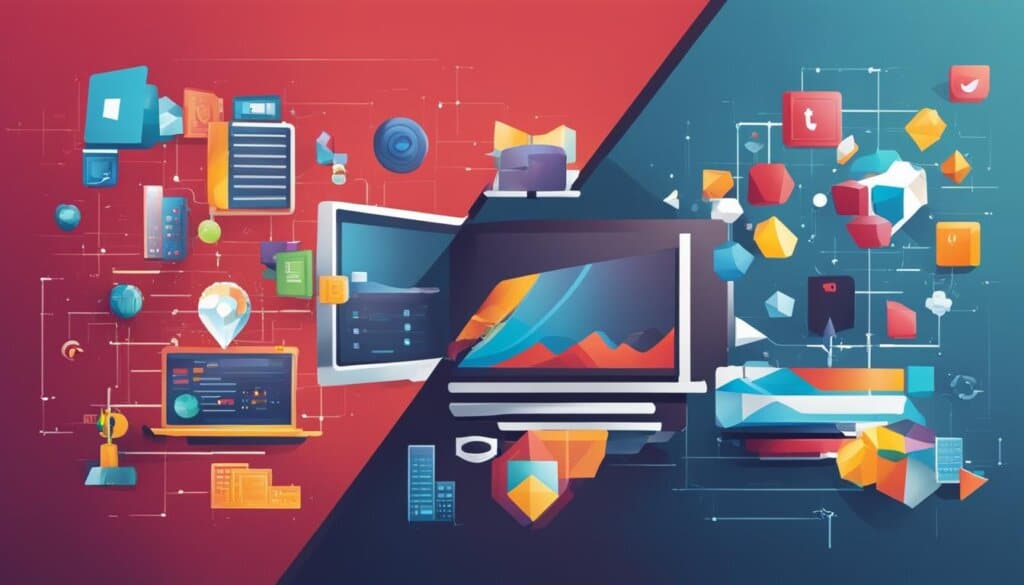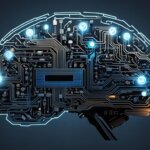Table of Contents
ICT, or information and communications technology, refers to the infrastructure and components that enable modern computing. It encompasses devices, networking components, and applications that facilitate data sharing and interaction in the digital world. ICT plays a pivotal role in various areas such as business, education, medicine, problem-solving, and leisure activities. The technologies included in ICT range from traditional ones like telephones and radio to cutting-edge advancements like artificial intelligence and robotics.
What is ICT and its components?
ICT, or Information and Communications Technology, encompasses a wide range of technologies, devices, and components that enable effective communications, data sharing, and global connectivity. It goes beyond the mere list of components and includes their application in various domains. Let’s explore the key components that make up ICT:
Devices
ICT technologies include various devices that facilitate communication, data processing, and interaction. These devices can range from traditional ones like desktop computers, laptops, smartphones, and tablets, to emerging technologies such as wearables, Internet of Things (IoT) devices, and virtual reality headsets.
Networking Components
Networking is a crucial aspect of ICT. It involves the infrastructure and components that enable data transmission and connectivity between devices. This includes routers, switches, modems, Wi-Fi access points, LAN cables, and wireless technologies like Bluetooth and NFC.
Applications
ICT applications encompass the software and programs that run on devices and enable specific functionalities. These can include productivity tools like office suites, design software, customer relationship management (CRM) systems, and industry-specific applications such as electronic health records (EHR) for healthcare.
Communications Protocols
Communications protocols are a set of rules and standards that govern the exchange of data between devices and networks. They ensure compatibility, security, and seamless data transmission. Examples of protocols include TCP/IP, HTTP, SMTP, and SSL.
Information Security
Information security is a critical component of ICT. It involves measures and protocols to protect data from unauthorized access, breaches, and cyber threats. This includes encryption, firewalls, antivirus software, secure authentication methods, and security policies.
Governance Policies
Governance policies refer to the guidelines, regulations, and standards that organizations and governments implement to ensure the proper use and management of ICT resources. These policies cover areas such as data privacy, intellectual property rights, data retention, and ethical use of technology.
ICT technologies, devices, networking components, applications, communications protocols, information security, and governance policies converge to create a robust and interconnected digital ecosystem that powers modern communication and information sharing.
To visualize the components of ICT, refer to the table below:
| Component | Description |
|---|---|
| Devices | Hardware devices that enable communication and data processing |
| Networking Components | Infrastructure and devices that facilitate data transmission and connectivity |
| Applications | Software programs that enable specific functionalities |
| Communications Protocols | Rules and standards that govern data exchange between devices and networks |
| Information Security | Measures and protocols to protect data from unauthorized access and cyber threats |
| Governance Policies | Guidelines and regulations for the proper use and management of ICT resources |
ICT vs. IT: Understanding the Difference
While ICT and IT are sometimes used interchangeably, they have different scopes. ICT refers to a broader range of components related to computer and digital technologies, including hardware, software, and networking. IT, on the other hand, focuses more specifically on the management of information and its technical aspects, such as software, hardware, and networking. IT can be considered a subset of ICT, as it deals with the management of information within the broader scope of ICT.
To better understand the difference between ICT and IT, let’s break down their components:
ICT Components
- Hardware: Includes devices such as computers, servers, routers, and smartphones.
- Software: Encompasses operating systems, applications, and programs that enable various functionalities.
- Networking: Involves wired and wireless networks, protocols, and communication technologies.
IT Components
- Software: Focuses on the management and development of software systems, including applications and databases.
- Hardware: Deals with the selection, installation, and maintenance of computer hardware.
- Networking: Manages and maintains network infrastructure and communication protocols.
While both ICT and IT are essential in the digital age, ICT has a broader scope that encompasses hardware, software, and networking, whereas IT focuses on managing information and the technical aspects of software, hardware, and networking.
In summary, ICT and IT are closely related but have distinct areas of focus. ICT includes a wide range of components required for computer and digital technologies, while IT concentrates on the management of information and its technical aspects. Understanding these differences is crucial for individuals and organizations looking to navigate the ever-evolving landscape of information and technology.
| ICT | IT |
|---|---|
| Encompasses hardware, software, and networking | Focuses on the management of information and its technical aspects |
| Broad scope | Narrower scope within ICT |
| Includes components required for modern computing | Manages software, hardware, and networking within the ICT framework |

ICT’s Importance in Business
ICT, or information and communications technology, has had a profound impact on the business landscape, presenting businesses with a plethora of benefits and opportunities. By harnessing the power of ICT, organizations have been able to streamline and automate their processes, resulting in significant cost savings. The advent of ICT has also given rise to the big data revolution, providing businesses with valuable insights that fuel innovation and the development of new products and services.
One of the key advantages of ICT in business is the facilitation of ICT-enabled transactions. These transactions span various domains, such as internet shopping, telemedicine, and social media, enabling customers to enjoy greater convenience and choice in how they shop and communicate. The digital platforms powered by ICT have opened up new avenues for businesses to engage with customers and expand their reach.
ICT plays a pivotal role in revolutionizing the business landscape. It has brought about highly automated processes, cost savings, and the big data revolution, empowering organizations with valuable insights for new products and services.
However, along with its benefits, ICT also poses challenges for businesses. Cybercrime is a pressing concern, as businesses face the constant threat of data breaches and privacy breaches. The automation enabled by ICT also raises questions about the displacement of workers and the need to adapt to new job roles in the digital era.
ICT and the Digital Age: Bridging the Digital Divide
ICT has played a transformative role in society, propelling us into the digital age and driving economic development. It is widely considered as one of the driving forces behind the Fourth Industrial Revolution. However, it is important to recognize that not everyone has equal access to ICT technologies, resulting in a digital divide.
The digital divide refers to the gap between those who have access to and can effectively utilize ICT and those who do not. This divide exists not only between countries but also within societies, impacting individuals who are marginalized or face socio-economic challenges.
Recognizing the significance of bridging this divide, governments and non-government organizations have initiated various initiatives to promote equal access to ICT technologies. These initiatives aim to provide affordable ICT devices, improved internet connectivity, and digital skills training to underserved communities.
By reducing the digital divide and ensuring access to ICT, individuals and communities can benefit from the opportunities that the digital age presents. They can access information, educational resources, job opportunities, and essential services, regardless of their geographical location or socio-economic background.
Government initiatives
Many governments around the world have launched initiatives to bridge the digital divide and promote ICT inclusion. These initiatives involve the establishment of ICT infrastructure, such as broadband networks and public Wi-Fi hotspots in remote and underserved areas. Governments also provide subsidies or tax incentives to make ICT devices more affordable for low-income individuals.
Furthermore, governments invest in ICT training programs and digital literacy campaigns to ensure that individuals have the necessary skills to navigate the digital world and fully utilize ICT resources. These initiatives not only empower individuals but also contribute to economic growth and social development.
Non-government organizations
Non-government organizations (NGOs) also play a crucial role in bridging the digital divide through their diverse initiatives. They collaborate with local communities and partner with governments and businesses to provide ICT resources, training, and support to underserved populations.
NGOs often focus on empowering marginalized communities, including women, children, and individuals with disabilities, by offering tailored ICT programs and mentorship opportunities. These initiatives aim to improve digital skills, foster entrepreneurship, and enhance digital inclusion.
“Bridging the digital divide is not just about providing access to ICT but also about empowering individuals with the knowledge and skills necessary to leverage ICT for their personal and professional advancement”
In conclusion, ICT has revolutionized society and ushered in the digital age, but the digital divide remains a significant challenge. Governments and non-government organizations are making commendable efforts to bridge this divide and ensure access to ICT technologies for all. By working together, we can create a more inclusive and equitable digital future.
Courses and Training in ICT
To pursue a career in ICT, there are various courses and training options available. These include courses in information technology, computer science, database technology, networking, cybersecurity, and more. These courses provide the necessary knowledge and skills to work in different areas of ICT, such as programming, database management, software management, network administration, and technical support.
Whether you’re a recent school leaver or looking to upskill in your current role, there are training programs and educational institutions that cater to all levels of expertise in the field of ICT. From introductory courses for beginners to advanced certifications for professionals, the training options in ICT are diverse and comprehensive.
Information Technology (IT) Courses
Information technology courses cover a wide range of topics, including computer programming, software development, systems analysis, and web development. These courses equip students with the necessary skills to design, develop, and maintain software applications, manage databases, and ensure the smooth functioning of IT systems within an organization.
Computer Science Courses
Computer science courses delve into the theoretical foundations of computing and equip students with the knowledge and skills to analyze complex problems, develop algorithms, and design efficient software solutions. These courses cover areas such as data structures, algorithms, artificial intelligence, and computer graphics.
Database Technology Courses
Database technology courses focus on the design, implementation, and management of databases. Students learn about data modeling, database architecture, and SQL programming, which are essential skills for data management and analysis in organizations.
Networking Courses
Networking courses provide students with an understanding of computer networks and equip them with the skills to design, configure, and maintain network infrastructure. These courses cover topics such as network protocols, routing, switching, and network security.
Cybersecurity Courses
Cybersecurity courses address the growing need for professionals who can protect computer systems from cyber threats and ensure the security of digital assets. These courses cover topics such as network security, cryptography, ethical hacking, and incident response.
“The demand for skilled professionals in ICT is on the rise, and acquiring the right knowledge and skills through courses and training programs is essential to thrive in this fast-paced industry.” – John Smith, ICT Industry Expert
Benefits of ICT Courses and Training
Enrolling in ICT courses and training programs can provide numerous benefits, including:
- Gaining in-depth knowledge and understanding of ICT concepts and technologies
- Developing practical skills through hands-on learning and projects
- Enhancing career prospects and job opportunities in the ICT industry
- Keeping up with the evolving trends and advancements in information technology
The Role of ICT in Companies
ICT plays a crucial role in companies, offering numerous advantages that contribute to their success in the digital era. One of the key benefits of ICT is improved communication. Through ICT tools and platforms, companies can easily connect and collaborate with employees, clients, and partners, regardless of their geographical location. This enables efficient and effective communication, leading to better teamwork and streamlined business processes.
Another advantage of ICT in companies is the ability to share and manage data. With ICT systems and software, companies can store, organize, and access large amounts of data, facilitating efficient data analysis and decision-making. Effective information management is essential for companies to gain valuable insights, make informed decisions, and stay ahead of the competition.
However, implementing and managing ICT in companies also brings its own set of challenges. One of the major challenges is the cost associated with acquiring and maintaining ICT infrastructure and technologies. This includes the purchase of hardware, software licenses, network equipment, and the allocation of resources for maintenance and upgrades. Additionally, companies need to invest in employee training to ensure they have the necessary skills to effectively use ICT tools and systems.
Furthermore, poor information management can pose a risk to companies. If data is not effectively organized, secure, and accessible, it can result in poor decision-making and hinder business operations. This highlights the importance of implementing robust information management practices, including data security measures, data governance policies, and regular data backups.
Despite these challenges, ICT remains crucial for the future success of companies. Its advantages in communication, data sharing, and effective information management outweigh the challenges. By embracing ICT, companies can enhance their operations, improve productivity, and capitalize on the opportunities offered by the digital revolution.
FAQ
What is ICT?
ICT stands for information and communications technology. It refers to the infrastructure and components that enable modern computing and facilitate data sharing and interaction in the digital world.
What does ICT encompass?
ICT encompasses a wide range of technologies, devices, and components. It includes devices (hardware), software, middleware, data, wired and wireless networks, communication technologies, the cloud, communications protocols and interfaces, as well as information security and governance policies.
What is the difference between ICT and IT?
While ICT and IT are sometimes used interchangeably, they have different scopes. ICT refers to a broader range of components related to computer and digital technologies, including hardware, software, and networking. IT focuses more specifically on the management of information and its technical aspects, such as software, hardware, and networking.
What are the key applications of ICT in business?
ICT has revolutionized the business landscape by bringing numerous benefits and opportunities. It has led to highly automated business processes, cost savings, and the big data revolution where organizations leverage data insights for new products and services. ICT has also enabled ICT-enabled transactions like internet shopping, telemedicine, and social media, giving customers more choices in how they shop and communicate.
How does ICT bridge the digital divide?
ICT has played a pivotal role in economic development and is often credited with ushering in the Fourth Industrial Revolution. However, there is a digital divide that exists, where access to ICT is not evenly distributed among countries and individuals. Governments and non-government organizations have implemented various initiatives to bridge this divide and provide greater access to ICT technologies for those who struggle to afford them.
Are there courses and training options available in ICT?
Yes, there are various courses and training options available for those interested in pursuing a career in ICT. These include courses in information technology, computer science, database technology, networking, cybersecurity, and more. These courses provide the necessary knowledge and skills to work in different areas of ICT, such as programming, database management, software management, network administration, and technical support.
What is the role of ICT in companies?
ICT plays a crucial role in companies by offering advantages such as improved communication, data sharing, and marketing. It enables effective information management, which is essential for making informed decisions. However, implementing and managing ICT in companies also brings challenges such as high costs, the need for infrastructure and employee training, and the risk of poor decision-making if information is not effectively managed.













